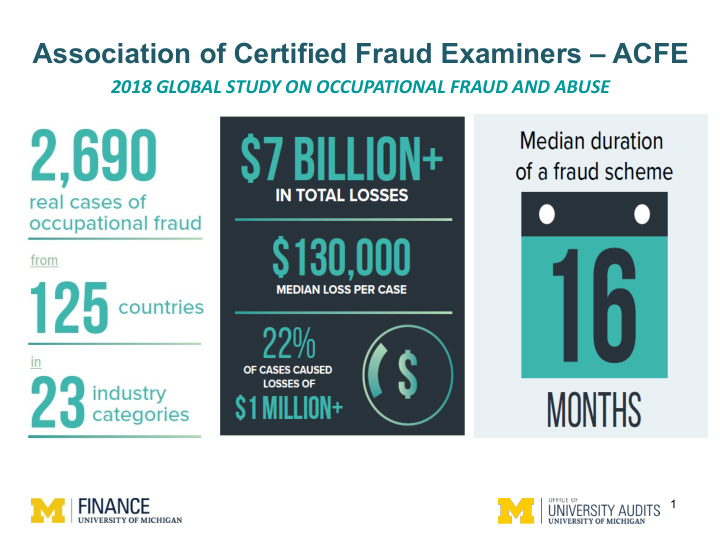



Association of Certified Fraud Examiners – ACFE 2018 GLOBAL STUDY ON OCCUPATIONAL FRAUD AND ABUSE 1
Key Findings 2
The Red Flags of Fraud Understanding and recognizing the behavioral red flags displayed by fraud perpetrators can help organizations detect fraud and mitigate losses. 3
Fraud Types and Identification 4
Hotlines & Reporting Mechanisms NOT ALL TIPS COME THROUGH HOTLINES When a reporting mechanism is not used, whistleblowers are most likely to report to: • Direct Supervisor 32% • Executive 15% • Fraud Investigation Team 13% • Coworker 12% • Internal Audit 10% 5
Internal Control Weaknesses that Contribute to Fraud 6
Fraud and Investigations It is estimated that the typical organization loses 5% of revenues to fraud each year 1 . Fraud can happen anywhere and unfortunately, it happens at the University of Michigan. Below are some examples of cases that have been investigated recently. These examples are presented for your awareness and to get you thinking about the risk of fraud in your unit and what controls you have in place to prevent it or detect it in a timely way. An employee used the PCard to pay for personal An employee processed customer refunds to expenses. their own credit card. How was this discovered? The employee did not How was this identified? A customer called to submit the expenses through Concur. Email inquire about an expected refund that had not notifications/reports about unsubmitted expenses yet been received. The employee who typically were not received by the supervisor or the handles refunds was out, so the call was handled department manager. Expenses were identified by by a co‐worker. Procurement Services reviewing expenses over 90‐ What happened? The employee is on days old. administrative leave while a DPSS investigation is How did it turn out? The employee was terminated. in progress. What important control was missing? No default What important control was missing? The approver was listed for the employee in Concur. If a approval of refunds was verbally delegated to the default approver had been listed, the supervisor employee performing the refunds and no would have received an email about unsubmitted compensating oversight control was in place to expenses and they would have been identified faster. detect the fraud. This was a trusted employee, The correct department manager was not listed in who was a “friend” of the supervisor. The the system, so the burst reports on unsubmitted employee was targeting older credit balances expenses were not received by the right person. that customers may have forgotten. A faculty advisor to a student group was being paid An employee was not reporting time off on their by the group to video its events. university timesheet to save vacation days. Why was this a problem? Students from the group How was this discovered? Coworkers noticed called the hotline because of a conflict of interest discrepancies between actual attendance and situation. Because he was their faculty advisor, they time reports and called the hotline. felt obligated to use him for video services. So what? Theft of time from the university might What was the result? The faculty advisor was seem small at an individual or department level, required to stop providing videography services to but from a university‐wide perspective, the loss this group. may be significant. Why is this a critical example? This is an abuse of Why is this a critical example? A supervisor’s power situation. Without a hotline, there may have sloppiness can allow a fraud to continue. A been no place the students felt comfortable raising supervisor with local knowledge about what was their concerns. The perception of a conflict can truly worked and who can attest to the accuracy create problems. Real and potential conflicts of of the timesheet is the key control. No report interest must be disclosed, discussed, and managed. can be run centrally to identify this fraud. Any suspicious activity should be reported to University Audits (734) 647‐7500 or to the Compliance Hotline at 1‐866‐ 990‐0111 or compliance hotline.umich.edu. Callers to the Compliance Hotline can remain anonymous. Departments that will likely be involved in a fraud investigation include DPSS, HR, OGC, University Audits, and Risk Management. 1 From the ACFE’s 2018 Global Fraud Study, Report to the Nations on Occupational Fraud and Abuse. December 12, 2018
Compliance Hotline Statistics Below are some statistics about the Compliance Hotline. It is important to note that not all reports to the hotline are about fraud. Some are other forms of misconduct, but all are reviewed. It is also important to note that not all fraud is reported through the Hotline. Sometimes reports are made directly to units (e.g., Procurement Services, University Audits, DPSS, HR, OGC). These and many other departments work together to safeguard university personnel and assets. Number of Hotline Reports fiscal year 2012‐2018 700 600 500 400 300 200 100 0 FY 2012 FY 2013 FY 2014 FY 2015 FY 2016 FY 2017 FY 2018 Location FY 2016 FY 2017 FY 2018 Ann Arbor Campus 41 101 246 Dearborn Campus 2 2 5 Flint Campus 7 21 22 Michigan Medicine/Medical School 249 375 321 Total 299 499 594 Method of Reporting FY 2016 FY 2017 FY 2018 Internet 176 351 404 Phone 122 148 190 Other 1 Total 299 499 594 Anonymous/Non‐ anonymous FY 2016 FY 2017 FY 2018 Anonymous 94 364 206 Non‐anonymous 205 135 388 Total 299 499 594 December 12, 2018
Recommend
More recommend